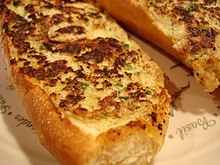 | |
| Course | Main course or snack |
|---|---|
| Place of origin | Singapore [1] [2] |
| Serving temperature | warm |
| Main ingredients | bread, egg, onions, meat or fish |
Roti john is an omelette sandwich which originated in Singapore in the 1960s or 1970s. It has since become a popular street food dish in Singapore, Malaysia and Indonesia. [2] [3] [4] [5] [6]

